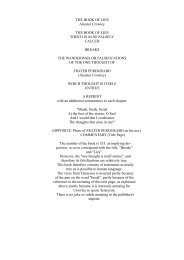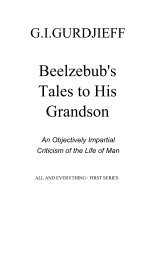Richard Rose’s Psychology of the Observer The Path to Reality Through the Self
John-Kent-Richard-Rose's-Psychology-of-Observer-Path-to-Reality-Thru-the-Self
John-Kent-Richard-Rose's-Psychology-of-Observer-Path-to-Reality-Thru-the-Self
Create successful ePaper yourself
Turn your PDF publications into a flip-book with our unique Google optimized e-Paper software.
200 <strong>Richard</strong> <strong>Rose’s</strong> <strong>Psychology</strong> <strong>of</strong> <strong>the</strong> <strong>Observer</strong>: <strong>The</strong> <strong>Path</strong> <strong>to</strong> <strong>Reality</strong> <strong>Through</strong> <strong>the</strong> <strong>Self</strong><br />
This reference <strong>to</strong> power brings up a fur<strong>the</strong>r consideration: betweenness implies a state that is<br />
in between two opposing or complementary poles. This opposition in forces results in tension between<br />
<strong>the</strong>m, like that <strong>of</strong> two magnets <strong>of</strong> <strong>the</strong> same charge placed facing each o<strong>the</strong>r. It is <strong>the</strong> energy<br />
from this tension that Zen wishes <strong>to</strong> exploit in <strong>the</strong> work on <strong>the</strong> koan, which, when reaching its culmination<br />
<strong>of</strong> intensity, explodes, leaving behind a stillness that is <strong>the</strong> doorway <strong>to</strong> a higher level <strong>of</strong> being.<br />
Rose has said that life itself is tension at work; life being a force resulting from less sophisticated<br />
elements in interaction. Our very existence issues from this magic <strong>of</strong> betweenness. He adds<br />
that with each new form <strong>of</strong> life generated from <strong>the</strong> energy <strong>of</strong> this interaction, a more subtle life-form is<br />
developed (Rose, 1975, p. 30). Much <strong>of</strong> spiritual work is <strong>the</strong> deliberate intensification <strong>of</strong> this process <strong>of</strong><br />
transmutation.<br />
He claims that <strong>to</strong> achieve anything significant in life, especially spiritual attainment, this tension<br />
is essential. Despite our perpetual, nostalgic longing for a world <strong>of</strong> harmony and beauty, he says<br />
that discord and frustration can be more propitious for promoting inner work. He states: “Bro<strong>the</strong>rhood<br />
and peace on Earth are not good (for attainment). Strife and conflict are.” Not only does he say:<br />
“Nothing <strong>of</strong> importance happens without tension,” he adds: “<strong>The</strong>re is no tension without polarity,<br />
and <strong>the</strong>re is no real understanding or wisdom without tension” (Rose, 1985, p. 265). In fact, one<br />
revealing definition <strong>of</strong> spiritual capacity Rose has given is: how much tension one can maintain (without<br />
dissipating it in some form). He has described spiritual work as being, in part: “Continuing <strong>to</strong> bang<br />
your head against <strong>the</strong> wall. This prepares you <strong>to</strong> bang your head against bigger and bigger walls.”<br />
This attitude requires a particular quality <strong>of</strong> self-sufficiency and containment, freedom from<br />
projection, and singleness <strong>of</strong> purpose. Rose has bluntly stated: “If you need entertainment or escape,<br />
you are asleep.” He repeatedly points out that we must learn <strong>to</strong> live without <strong>the</strong> dream: about ourselves,<br />
about life, and about spiritual imaginings. He has defined “stature” <strong>to</strong> mean being able <strong>to</strong> stand<br />
alone without pride or egos, and being one with proper action. Peace <strong>of</strong> mind means: “Refuse <strong>to</strong> be<br />
troubled by what happens <strong>to</strong> you—don’t identify with it.” He again conjures up <strong>the</strong> image <strong>of</strong> <strong>the</strong> Zen<br />
warrior when he states: “To be free <strong>of</strong> <strong>the</strong> need for security is security.”<br />
What is <strong>the</strong> composition <strong>of</strong> this special quality <strong>of</strong> tension which Rose is encouraging? Quite<br />
simply: it is <strong>the</strong> gap between knowing and unknowing. Between longing and emptiness. Being and<br />
non-being. Life and death. Hope and despair. He explains its significance:<br />
<strong>The</strong> uncompromisable point in <strong>the</strong> center between opposites leads <strong>to</strong> a dead s<strong>to</strong>p; this<br />
tension creating <strong>the</strong> third force. To generate this vec<strong>to</strong>r <strong>of</strong> power, we need <strong>to</strong> insure<br />
that this catalytic midpoint is unvarying. Like <strong>the</strong> two lovers, never let <strong>the</strong>m <strong>to</strong>uch, yet<br />
allow <strong>the</strong>m <strong>to</strong> be close enough <strong>to</strong> insure that both are equally aware <strong>of</strong> <strong>the</strong> o<strong>the</strong>r. <strong>The</strong><br />
apex <strong>of</strong> <strong>the</strong> triangle will be limited <strong>to</strong> <strong>the</strong> power <strong>of</strong> <strong>the</strong> two opposite directions <strong>of</strong> force,<br />
meaning <strong>the</strong> importance or anxiety that <strong>the</strong>se directions make in <strong>the</strong> mind <strong>of</strong> <strong>the</strong> seeker<br />
(Rose, 1985, p. 265).<br />
He has said that one <strong>of</strong> <strong>the</strong> keys <strong>to</strong> continued movement along <strong>the</strong> path is <strong>to</strong> always be dissatisfied<br />
with what one is doing and experiencing. However, as always, he has indicated <strong>the</strong> opposite<br />
attitude as well: that one should “Love being—rejoice in <strong>the</strong> work and signs <strong>of</strong> progress.” This latter<br />
paradox in attitude results in a highly focused individual; one who is solid as a rock yet light and<br />
transparent as air, and whose identity is finally that <strong>of</strong> an unanswered question, living without relative,<br />
psychological need.<br />
<strong>The</strong> way <strong>of</strong> betweenness on <strong>the</strong> path can be succinctly defined by an elaboration on <strong>the</strong> famous<br />
old soliloquy: “To be or not <strong>to</strong> be—that is <strong>the</strong> question.” In response: “To be and not <strong>to</strong> be—<br />
that is <strong>the</strong> answer”.




